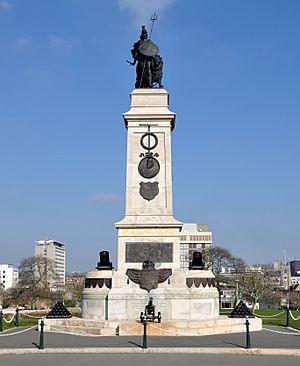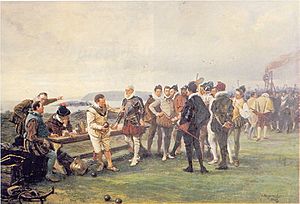Armada Memorial facts for kids
 |
|
| Coordinates | 50°21′55″N 4°08′30″W / 50.3653°N 4.1416°W |
|---|---|
| Location | Plymouth Hoe, Plymouth, Devon, England |
| Designer | Herbert Gribble |
| Material | Granite, bronze |
| Completion date | 1888 |
|
Listed Building – Grade II*
|
|
| Official name | Armada Memorial |
| Designated | 1 May 1975 |
| Reference no. | 1386461 |
The Armada Memorial is a special monument found on Plymouth Hoe, in Plymouth, Devon, England. It was built in 1888. This monument celebrates 300 years since the defeat of the Spanish Armada. The Armada was a huge fleet of Spanish ships. English captains first saw these ships from Plymouth. The memorial is made of strong granite and has cool bronze decorations. It also features a statue of Britannia, who represents Great Britain.
Remembering the Spanish Armada
The Spanish Armada was a large fleet of ships from Spain. They tried to invade England by sea, but they were not successful. News that the Armada was coming reached Plymouth on July 19. The ships were seen on July 20.
A famous story says that English captains were playing bowls on Plymouth Hoe when they heard the Armada was close. The story also tells us that Francis Drake said something brave. He supposedly said, "There is time enough to play the game out first, and thrash the Spaniards afterwards."
For many years, the bells of St Andrew's church would ring happily. This happened every year on the Saturday before July 25. It was a way to remember the Armada's defeat. This tradition stopped in the 1800s. A statue of Francis Drake was put up on the Hoe in 1884.
Building the Memorial
The first stone for the Armada Memorial was put in place on July 19, 1888. The Mayor of Plymouth, Henry Waring, led the ceremony. This day was chosen to mark 300 years since the Armada was first seen from the Hoe. People came from all over to see the ceremony. It was a public holiday in the city. There was also a big dinner at the city's Guildhall.
The memorial was officially opened later by the Duke of Edinburgh, Alfred. This happened on October 21, 1890. It was a grand event with many important people and military displays. The memorial became a special listed building on May 1, 1975. This means it is protected for its historical importance.
Design of the Monument
The Armada Memorial was designed by architect Herbert Gribble. The sculptures were made by William Charles May. The monument is mostly made of granite. It has many detailed carvings and bronze parts.
The bottom of the monument has steps and is shaped like an octagon (eight sides). On top of this is a square base. This base has a shield decorated with fabric and a crown. One part of the monument shows a panel with words about the battle. It says, "HE BLEW WITH HIS WINDS AND THEY WERE SCATTERED". This phrase means God helped the English by sending strong winds that scattered the Spanish ships.
Higher up, there is a round medal and a chest with a head on it. Some historians think this head might be of the Spanish admiral, Sedonia. At the very top of the monument stands a bronze statue of Britannia. She is a female figure who represents Great Britain, and she stands with a lion. A fence made of cast-iron posts and chains surrounds the memorial. The stone used for the memorial came from Gunnislake, in Cornwall. It was known for being a very white and fine-grained granite.


